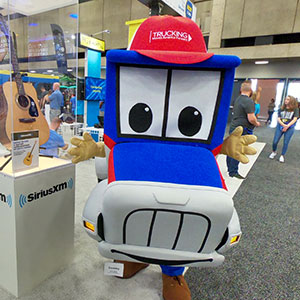Fleet Owner: Obama pushes infrastructure investment, aims to slash red tape
By Brian Straight
Saying that he will use executive actions when appropriate, President Barack Obama promised to slash the red tape holding back infrastructure projects in this country during his fifth State of the Union address last night. He also reiterated his administration’s promise to implement further fuel efficiency targets for heavy-duty trucks beyond the current regulations that begin phasing in this year.
Noting the partisanship that exists in Washington, Obama asked Congress a simple question: “The question for everyone in this chamber, running through every decision we make this year, is whether we are going to help or hinder this progress,” he said, noting that progress was made in this area with the recent budget deal.
But, he added, more needs to be done.
“Our job is to reverse these trends. It won’t happen right away, and we won’t agree on everything. But what I offer tonight is a set of concrete, practical proposals to speed up growth, strengthen the middle class, and build new ladders of opportunity into the middle class. Some require Congressional action, and I’m eager to work with all of you. But America does not stand still – and neither will I. So wherever and whenever I can take steps without legislation to expand opportunity for more American families, that’s what I’m going to do,” he said.
One of those first executive actions was his announcement that he was boosting the minimum wage for all new federal contract workers to $10.10/hr.
The next test may come in the form of slashing red tape for infrastructure projects. Proposing to tie infrastructure investment to tax reform, Obama hopes to “create jobs rebuilding our roads, upgrading our ports, unclogging our commutes – because in today’s global economy, first-class jobs gravitate to first-class infrastructure. We’ll need Congress to protect more than three million jobs by finishing transportation and waterways bills this summer. But I will act on my own to slash bureaucracy and streamline the permitting process for key projects, so we can get more construction workers on the job as fast as possible.”
Dept. of Transportation secretary Anthony Foxx said he would work to help bring Obama’s vision of an improved infrastructure to fruition.
“I will be working throughout the year from the federal to the local level to build more infrastructure while growing jobs now and making more jobs possible with first-rate transportation networks,” Foxx said in a statement. “We will also build ladders of opportunity, connecting every American to the global economy. I was especially glad to hear the president call on Congress to finish a much-needed transportation bill this summer, and the proposal to fund that bill through corporate tax reform can and should be done on a bipartisan basis.”
The American Trucking Assns. (ATA), though pleased with the comments, remained concerned about the lack of concrete ideas on how to increase investment.
“While we appreciate President Obama making reference to the need for infrastructure investment, we remain disappointed in the continued lack of specificity when he discusses funding,” said Bill Graves, ATA president and CEO, in a statement immediately following the address. “While it is critically important to the nation that Congress and the administration come together on a multiyear highway bill this year, we believe that until the administration puts forward a serious, user-based funding proposal we will risk going over the Highway Trust Fund ‘fiscal cliff’ in the near term and be woefully underfunded to meet the longer term needs of the nation.”
A mid-summer hearing in 2013 on the Highway Trust Fund included testimony from the Congressional Budget Office (CBO) that indicated “the revenues derived from existing excise [fuel] taxes will fall far short of covering the spending that would result from continuing to obligate funds in the amounts provided for 2013, as adjusted for inflation.
“The current trajectory of the Highway Trust Fund is unsustainable,” CBO stated. “Starting in fiscal year 2015, the trust fund will have insufficient resources to meet all of its obligations, resulting in steadily accumulating shortfalls.”
“It was an honor to attend the State of the Union, but the president’s proposal was sorely lacking in details and comes up short of what the nation needs to maintain our economic competitiveness,” Graves added. “Trucks use our roads and bridges to move more than 70% of the nation’s freight and if do not address our infrastructure deficit the system will soon become a drag on our economic recovery and hinder our future growth.”
Reaction to the speech from Patrick Jones, executive director and CEO of the International Bridge, Tunnel and Turnpike Assn., the worldwide association representing toll facility owners and operators, remained in line with that organization’s goals – providing states more flexibility in funding options, including the ability to toll more roads.
“The transportation funding needs of states are great. The resources of the federal government are limited. Therefore, we ask Congress and the president to give states maximum flexibility to meet their individual transportation funding needs, including the use of tolling on the existing Interstate highway system,” Jones said. “While we respect the president’s willingness ‘to create jobs rebuilding our roads,’ we know that no one source of revenue can be sufficient to build, maintain, and reconstruct our nation’s bridges, tunnels, and highways. Now is the time for Congress, the president, and other elected leaders to seriously consider all options to meet our country’s transportation funding needs. Tolling is one of the most powerful, effective, and proven tools in the funding toolbox.”
Terry O’Sullivan, general president of the Laborers’ International Union of North America, was also pleased with the speech and hoped that it could lead to a long-term highway reauthorization to succeed MAP-21, which expires later this year.
“Hopefully the president’s remarks start the engine of passing a long-term reauthorization of the MAP-21 Highway bill. Now it’s time for Congress to move forward before our nation’s Highway Trust Fund runs out of gas. Passing a new long-term bill, for at least 6 years to come, could save hundreds of billions of taxpayer dollars,” said O’Sullivan. “Adjusting user fees for inflation, along with new bipartisan proposals for infrastructure banks and loan guarantees to develop more public-private partnerships, will help reduce a deficit that is expected to reach 15 billion dollars this year alone. These new investments in rebuilding America’s roads and bridges will create family-supporting jobs that help more working families earn their way into the middle class, one of the most powerful drivers for economic growth.”
Earlier this week, Bill Shuster, chairman of the House Transportation and Infrastructure Committee, said it is that committee’s goal to introduce and move out of committee a comprehensive transportation bill before August.
Obama also touted the ongoing growth of natural gas, particularly in transportation.
“If extracted safely, [natural gas] is the bridge fuel that can power our economy with less of the carbon pollution that causes climate change,” he said. “Businesses plan to invest almost $100 billion in new factories that use natural gas. I’ll cut red tape to help states get those factories built, and this Congress can help by putting people to work building fueling stations that shift more cars and trucks from foreign oil to American natural gas.”
He also reiterated his administration’s previously announced plan for a new round of fuel efficiency standards for heavy trucks.
“When we rescued our automakers, for example, we worked with them to set higher fuel efficiency standards for our cars. In the coming months, I’ll build on that success by setting new standards for our trucks, so we can keep driving down oil imports and what we pay at the pump,” Obama said.
Fuel efficiency standards are already starting to be phased in this year under joint agreement between the U.S. Dept. of Transportation (DOT) and the Environmental Protection Agency (EPA), along with input from the trucking industry, environmental groups, and state governments. Those rules, set to go into effect in stages between 2014 and 2018 and impose different fuel efficiency targets based on the size and weight of the vehicle involved:
Most, but not all, tractor-trailers will be required to achieve up to approximately a 20% reduction in fuel consumption and GHG emissions by model year 2018, saving up to 4 gals. of fuel for every 100 mi. traveled.
For heavy-duty pickup trucks and vans, separate standards are required for gasoline-powered and diesel trucks. These vehicles will be required to achieve up to about a 15% reduction in fuel consumption and GHG emissions by model year 2018. Under the finalized standards a typical gasoline or diesel powered heavy-duty pickup truck or van could save 1 gal. of fuel for every 100 mi. of travel.
Vocational vehicles – including delivery trucks, buses, and garbage trucks – will be required to reduce fuel consumption and greenhouse gas emissions by approximately 10% by model year 2018. These trucks could save an average of 1gal. of fuel for every 100 mi. of travel.
Earlier in 2013, the Obama administration announced a new round of standards for 2017 and beyond, although specifics have not been released as of yet.


